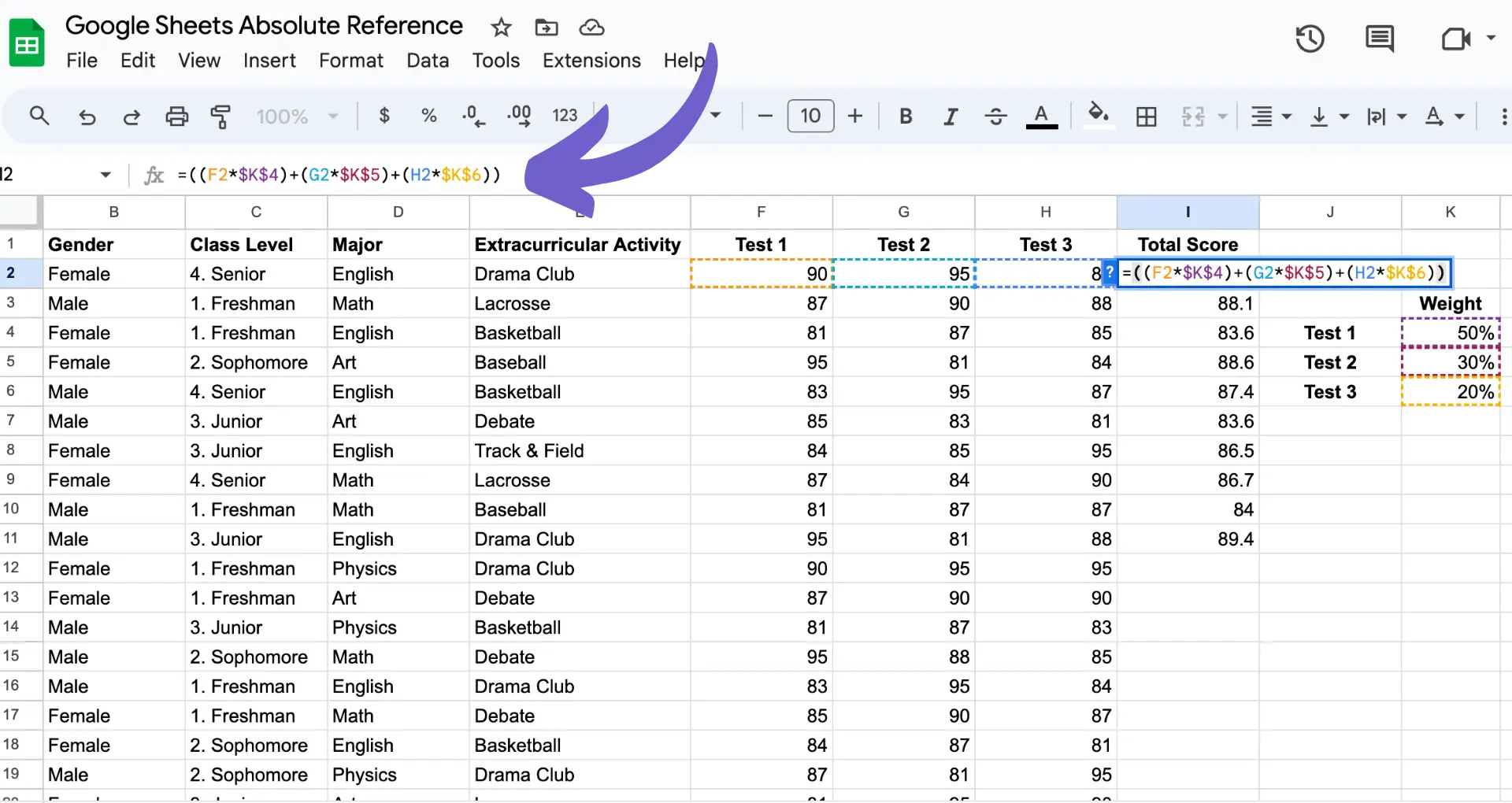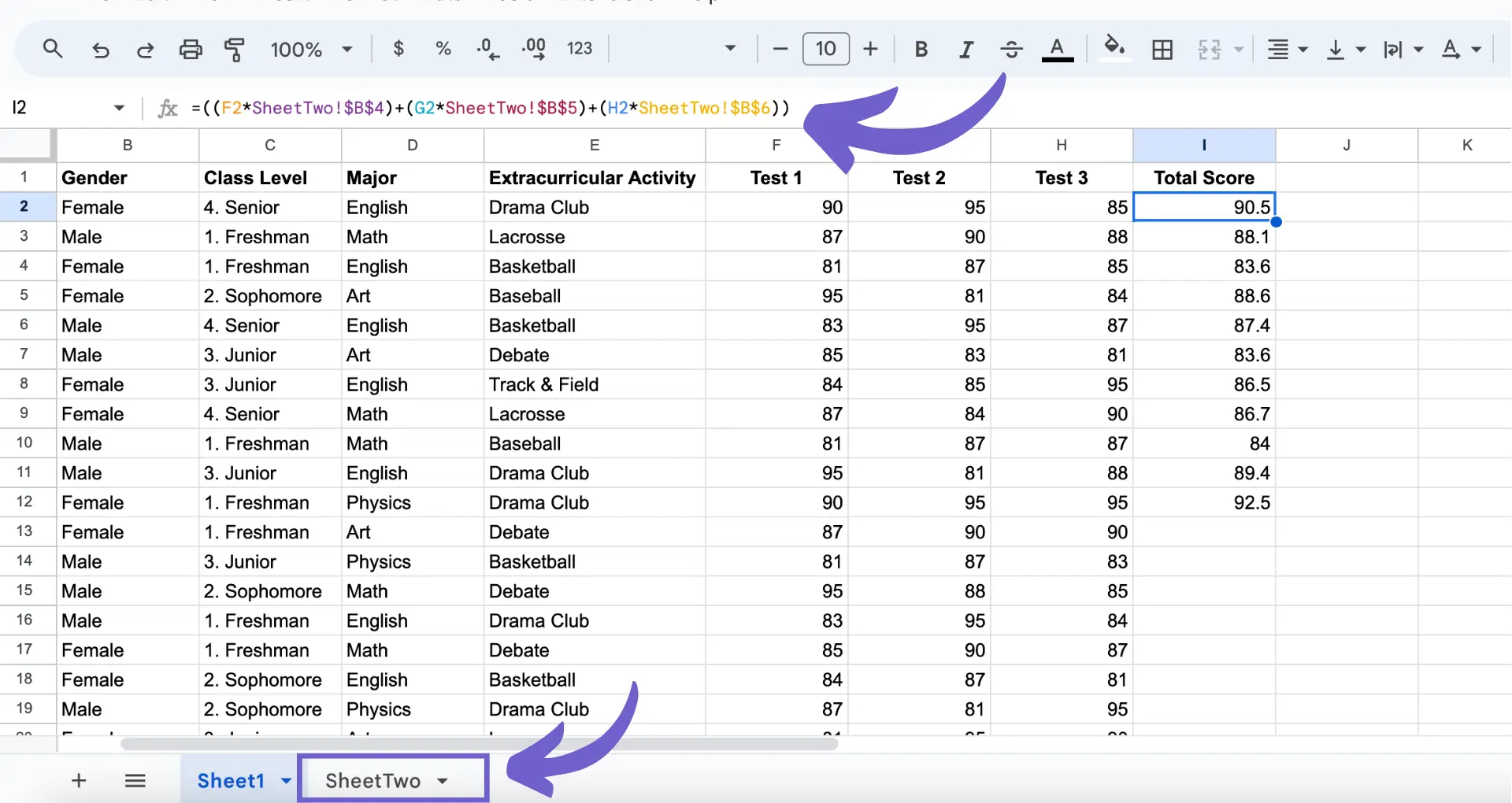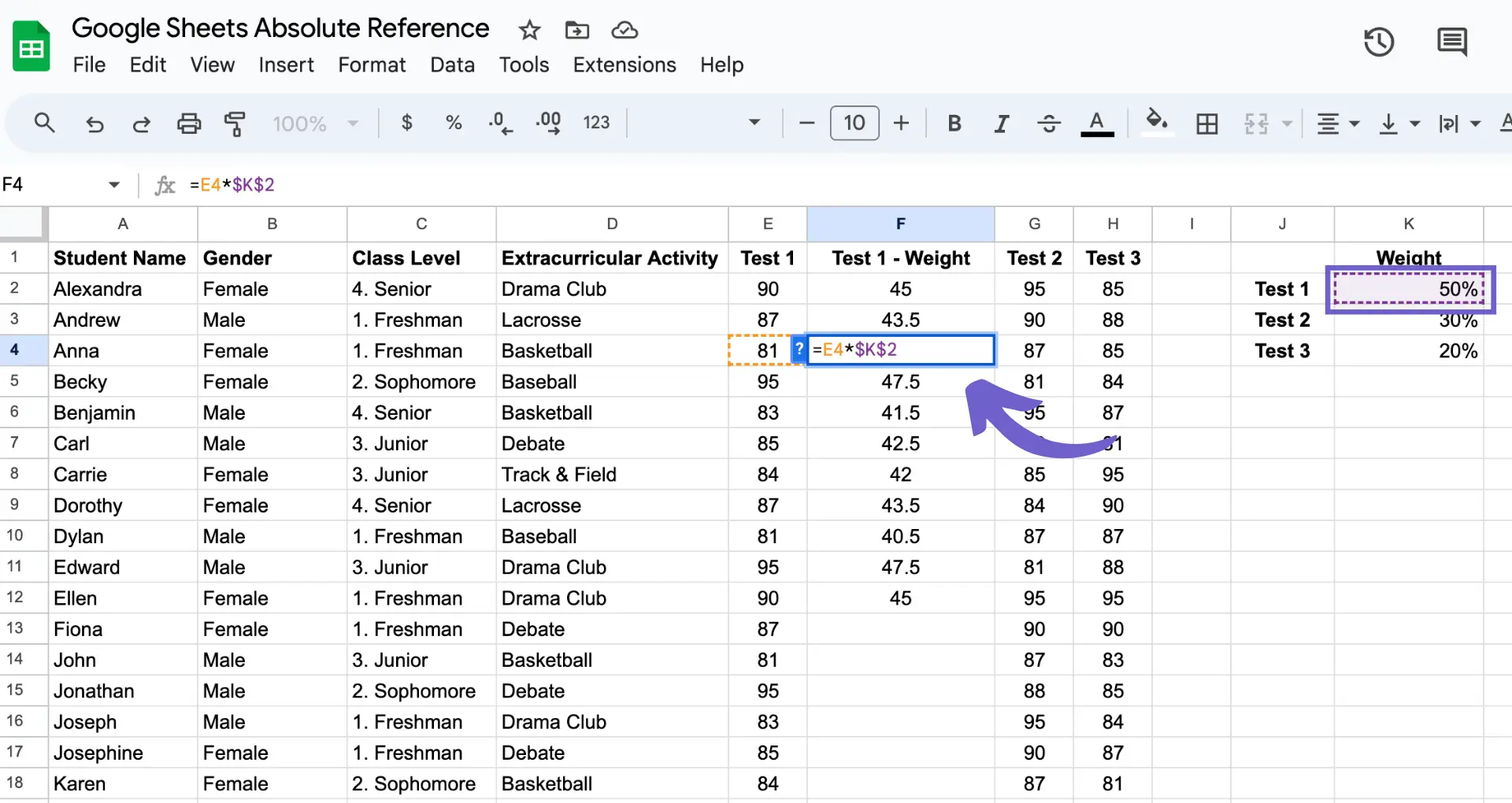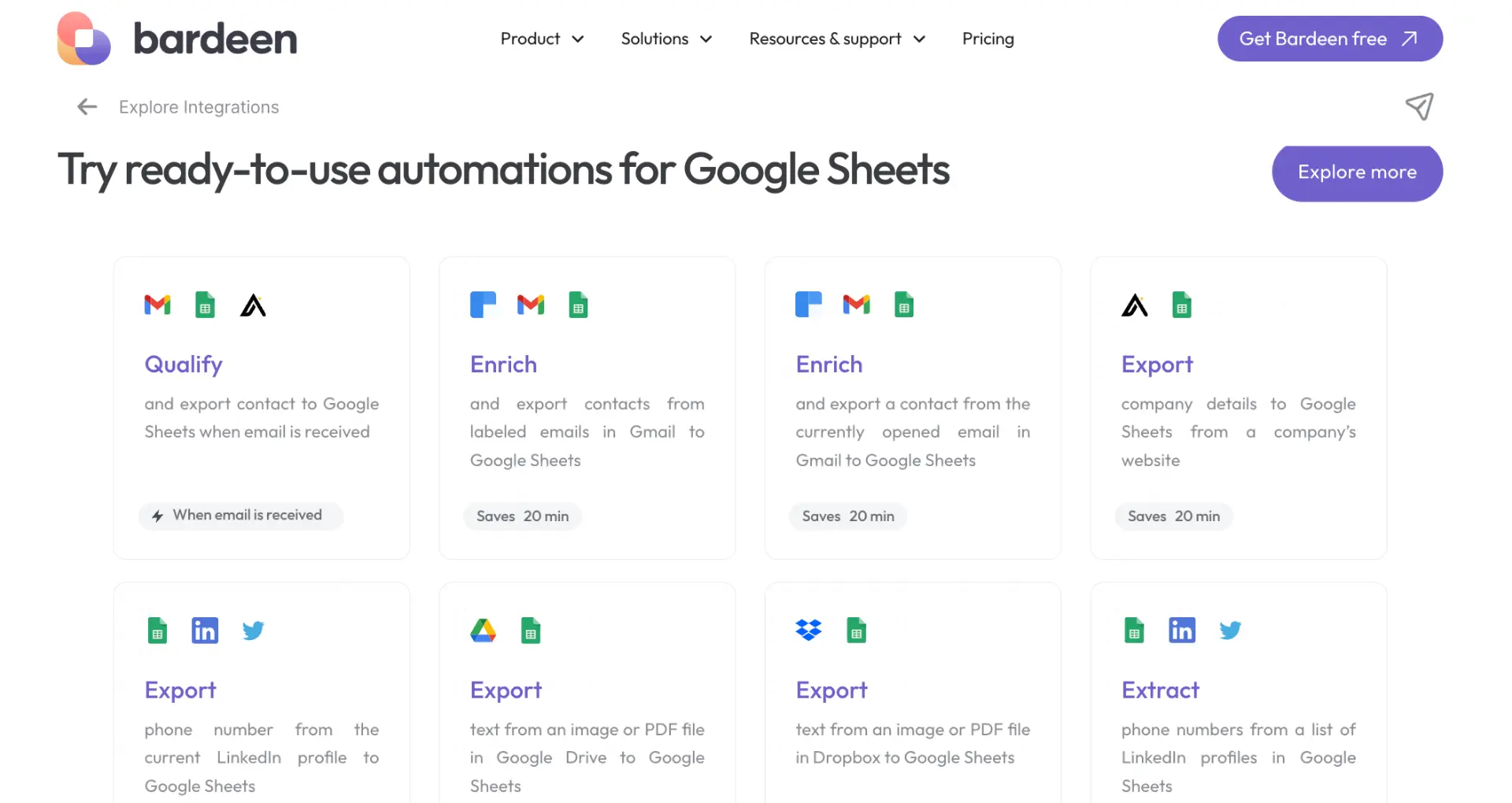Use $ to lock cells for absolute references in Google Sheets.
By the way, we're Bardeen, we build a free AI Agent for doing repetitive tasks.
If you use Google Sheets, check out our GPT in Spreadsheets feature. It automates complex tasks and saves you time.
In Google Sheets, understanding the difference between absolute and relative references is crucial for creating dynamic and error-free formulas. Absolute references allow you to lock a cell's row and column, ensuring that the reference remains constant when copied or filled to other cells. In this step-by-step guide, we'll walk you through the process of creating and using absolute references in Google Sheets, helping you become more efficient and accurate in your spreadsheet work.
Understanding Absolute vs. Relative References in Google Sheets
In Google Sheets, cell references are crucial for creating formulas that automate calculations and link data across your spreadsheet. There are two main types of cell references: absolute and relative.
- Relative references change when you copy or fill formulas to other cells. For example, if you have a formula =A1+B1 in cell C1 and copy it to cell C2, the formula will automatically adjust to =A2+B2.
- Absolute references remain constant, no matter where you copy or fill the formula. To create an absolute reference, add a dollar sign ($) before the column letter and row number, like $A$1. If you copy a formula with an absolute reference, it will always refer to the same cell.

Understanding the difference between relative and absolute references is essential for building effective formulas in Google Sheets. Relative references are perfect for creating formulas that need to be repeated across multiple rows or columns, while absolute references are ideal for referring to fixed values or cells that shouldn't change when copied.
To further enhance your productivity, consider using GPT in Google Sheets for automating more complex tasks.
How to Create an Absolute Reference in Google Sheets
Creating an absolute reference in Google Sheets is a straightforward process. Here's a step-by-step guide:
- Select the cell where you want to enter the formula containing the absolute reference.
- Begin typing your formula as usual.
- When you reach the part of the formula where you need to reference a cell that should remain constant, add a dollar sign ($) before the column letter and the row number. For example, instead of typing A1, type $A$1.
- Complete your formula and press Enter to see the result.
Alternatively, you can use a keyboard shortcut to create an absolute reference:
- Windows/Chrome OS: After typing the cell reference (e.g., A1), press the F4 key to toggle between relative and absolute references.
- Mac: After typing the cell reference, press Fn + F4 to toggle between relative and absolute references.
By pressing F4 (or Fn + F4) multiple times, you can cycle through the different reference types: relative (A1), absolute ($A$1), mixed with absolute column ($A1), and mixed with absolute row (A$1).
If you often use Google Sheets, consider how you can connect Google Sheets with other apps to streamline your work.

Bardeen makes it easy to enrich LinkedIn profile links in Google Sheets, saving you time and effort. Try it now to automate your data updates!
Practical Applications of Absolute References
Absolute references in Google Sheets are essential in various scenarios where you need to maintain the integrity of your formulas and calculations. Here are some practical applications:
- Using a fixed tax rate: When calculating taxes on multiple items, you can store the tax rate in a single cell and use an absolute reference to that cell in your formulas. This way, if the tax rate changes, you only need to update it in one place.
- Referencing static data across multiple sheets: If you have a value that remains constant across different sheets (e.g., a company's name or a specific date), you can use an absolute reference to ensure consistency and avoid errors when copying formulas.
- Creating a dynamic budget template: By combining absolute and relative references, you can create a budget template that automatically updates calculations when you input new values. For example, you can use absolute references for fixed costs and relative references for variable expenses.
Here's a sample spreadsheet setup that demonstrates how absolute references can solve common formula problems:
ItemPriceTax (10%)TotalProduct A$50=B2*$E$1=B2+C2Product B$75=B3*$E$1=B3+C3Product C$100=B4*$E$1=B4+C4Tax Rate:10%
In this example, the tax rate (10%) is stored in cell E1 and referenced using an absolute reference ($E$1) in the tax calculation formulas (C2, C3, C4). This allows you to copy the formulas down the column without changing the tax rate reference, ensuring accurate calculations for each product. For more advanced tasks, you can connect Google Sheets with Excel to enhance your workflow.
Mixing Absolute and Relative References
In Google Sheets, you can mix absolute and relative references to lock either rows or columns while allowing the other component to change when copying formulas. This is known as a mixed or partial reference. Here's how it works:
- To lock a row while allowing the column to change, place a dollar sign ($) before the row number (e.g., A$1).
- To lock a column while allowing the row to change, place a dollar sign ($) before the column letter (e.g., $A1).
Mixed references are particularly useful in situations where you need to maintain consistency in one dimension while allowing flexibility in the other. Some common applications include:
- Budgeting: You can use mixed references to lock the column containing budget categories while allowing the rows to change for different months or quarters.
- Sales reports: Mixed references can be used to lock the row containing sales representatives' names while allowing the columns to change for different metrics or time periods.
MonthSales Rep 1Sales Rep 2January=B$2*$D$1=C$2*$D$1February=B$3*$D$1=C$3*$D$1Commission Rate10%
In this example, the commission rate (10%) is stored in cell D1 and referenced using a mixed reference ($D$1) in the commission calculation formulas (B2, C2, B3, C3). The dollar sign before the column letter (D) ensures that the reference always points to column D, while the dollar sign before the row number (1) keeps the reference fixed on row 1. This allows you to copy the formulas down the rows for each month without changing the commission rate reference.

To further enhance your Google Sheets workflow, consider how you can connect Google Docs for seamless document management.
Bardeen can help you automate tasks and save time. Check out how to use Bardeen to automate enrichment and improve your workflows.
Troubleshooting Common Issues with Absolute References
When working with absolute references in Google Sheets, users may encounter some common mistakes that can lead to incorrect results or formula errors. Here are a few typical issues and how to resolve them:
- Incorrect placement of dollar signs: One of the most common mistakes is placing the dollar sign in the wrong position. Remember, the dollar sign should be placed before the column letter and/or row number (e.g., $A$1). If the dollar sign is misplaced or missing, the reference may not be fully absolute, leading to unexpected results when copying formulas.
- Overusing absolute references: While absolute references are useful in many situations, overusing them can make your formulas harder to understand and maintain. Be selective and only use absolute references when necessary, such as when referring to a fixed input value or a specific cell that shouldn't change when copying formulas.
- Mixing up relative and absolute references: Another common issue is accidentally mixing relative and absolute references within a formula. This can happen when manually typing references or when copying and pasting formulas. To avoid this, double-check your formulas and make sure the appropriate references are absolute or relative as intended.
To troubleshoot and correct errors related to absolute references, follow these tips:
- Check the placement of dollar signs: Carefully review your formulas and ensure that the dollar signs are placed correctly before the column letter and/or row number for each absolute reference.
- Use the F4 key to toggle references: Instead of manually typing dollar signs, use the F4 key (or fn + F4 on Mac) to quickly toggle between relative, absolute, and mixed references. This can help minimize typing errors and make it easier to update references as needed.
- Break down complex formulas: If you're working with a complex formula that includes multiple absolute references, try breaking it down into smaller, more manageable parts. This can make it easier to identify and fix any issues related to absolute references.
- Test your formulas: After creating or modifying a formula with absolute references, test it by copying it to different cells and verifying that the results are correct. This can help you catch any errors early on and ensure that your formulas are working as intended.
By being aware of these common issues and following the troubleshooting tips, you can effectively use absolute references in your Google Sheets formulas and avoid potential errors. For more advanced techniques, you might want to add ChatGPT to Google Sheets.

Automate Your Google Sheets with Bardeen Playbooks
While mastering Google Sheets absolute reference is key to leveraging the full power of spreadsheet manipulation, automating tasks within Google Sheets using Bardeen takes productivity and data management to the next level. By utilizing Bardeen's playbooks, you can automate repetitive tasks, ensuring data accuracy and saving valuable time.
Here are some examples of automation you can implement with Bardeen:
- Enrich and update leads from a Google Sheet, when new row is added [Beta]: This playbook automates the process of enriching lead data directly in Google Sheets. When a new row is added, it uses the lead's email address to gather more information and updates the sheet with enriched data, functioning seamlessly even when your device is offline.
- Create a ClickUp task when a Google Sheets spreadsheet is modified: Perfect for project management, this playbook creates tasks in ClickUp based on modifications in Google Sheets. It ensures that project tasks are dynamically updated, reflecting the latest changes in your data sheets.
- Enrich contacts using names and company information in Google Sheets: Enhance your contact management by automatically enriching contacts in Google Sheets with additional details such as email, title, and social profiles using Apollo.io. This playbook updates the sheet with new insights, keeping your contact information comprehensive and current.






.svg)
.svg)
.svg)
